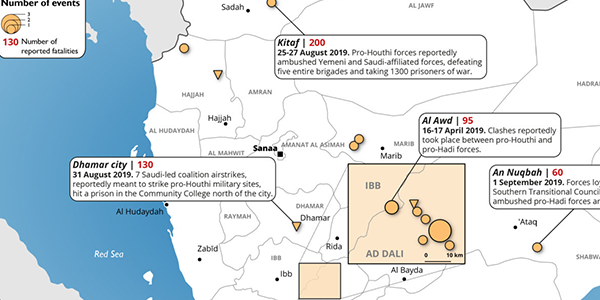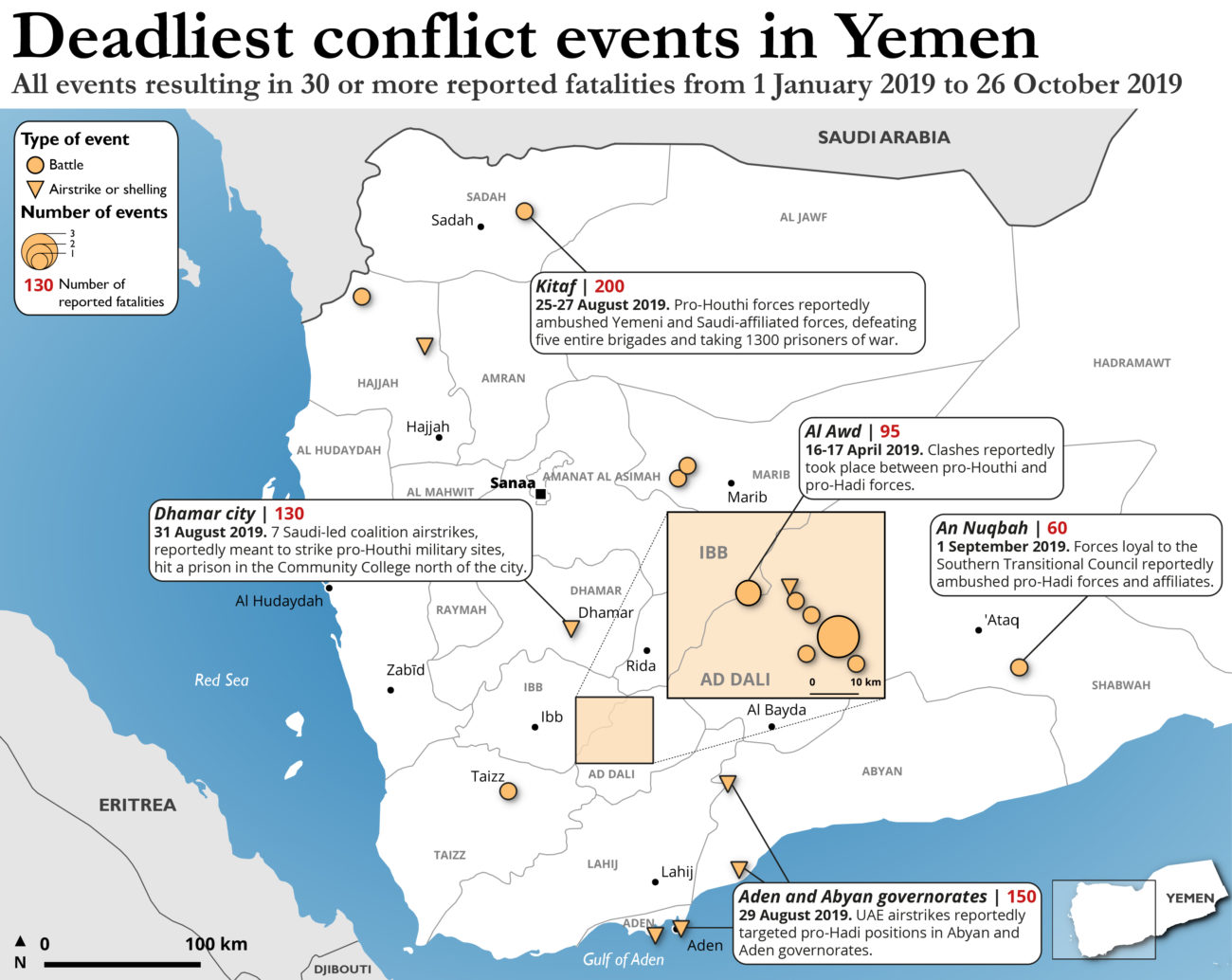31 October 2019: The Armed Conflict Location & Event Data Project (ACLED) currently records more than 100,000 reported fatalities in Yemen since 2015, including over 12,000 civilians killed in direct attacks. These findings are consistent with recent projections drawing on ACLED data issued by the United Nations Development Programme (UNDP) and the Frederick S. Pardee Center for International Futures, which estimate that approximately 102,000 people will be killed in direct violence by the end of 2019.1
ACLED’s Yemen data are collected in partnership with the Yemen Data Project.
The Conflict in 2019:
- ACLED records over 100,000 total reported fatalities from 2015 to the present2
- Approximately 20,000 have been reported so far in 2019, making it the second most lethal year after 2018
- More than 40,000 conflict events have been reported since the start of 2015
- Approximately 8,000 have occurred so far in 2019
- The monthly number of conflict events has declined since March
- This trend is primarily driven by a drop in explosions/remote violence events, such as shelling and airstrikes, while the number of battles has not decreased
- Deadly violence in 2019 is trending downward overall
- April was the most lethal month so far this year, with over 2,500 reported fatalities, compared to approximately 1,700 in September
- The third quarter of 2019 has seen the lowest number of reported fatalities since the end of 2017, largely due to a decline in battle intensity
- The number of coalition airstrikes declined over the past year, while Houthi attacks on Saudi Arabia increased until the group declared a unilateral ceasefire against targets inside Saudi territory in September
- Saudi Arabia only partially accepted the ceasefire proposal, and has continued to conduct attacks in Yemen
- In regions under Houthi control, ACLED has recorded an uptick in infighting between opposing Houthi factions
Impact on Civilians:
- ACLED records nearly 4,900 direct civilian targeting events resulting in more than 12,000 reported civilian fatalities since 20153
- Approximately 1,100 civilian fatalities have been reported so far in 2019
- The third quarter of 2019 registered the first month-to-month increase in reported civilian fatalities since the third quarter of 2018, rising 25% over the second quarter
- The Saudi-led coalition and its allies remain responsible for the highest number of reported civilian fatalities from direct targeting, with over 8,000 since 2015
- Around 67% of all reported civilian fatalities during this period have been caused by coalition airstrikes
- Though the number of coalition airstrikes is at an all-time low, civilian fatalities from air raids have risen for the first time since the end of 2017, more than doubling in the third quarter of 2019 compared to the previous quarter, primarily due to a strike on a prison facility in Dhamar that killed at least 130 detainees
- The Houthis and their allies are responsible for over 2,000 reported civilian fatalities from direct targeting since 2015
Geographic Focus:
- Taiz consistently registers as the deadliest governorate in Yemen, largely due to a four-year siege laid by Houthi forces, although violence has declined in 2019
- Over 19,000 reported fatalities have been recorded in total in the governorate since 2015 and more than 2,300 reported fatalities stem from direct civilian targeting
- Hodeidah and Al Jawf follow Taiz, with more than 10,000 total fatalities reported in each region since 2015
- Though deadly violence has decreased in Hodeidah and Taiz this year, other fronts in Ad Dali, Al Jawf, and Hajjah have registered heavy clashes: for these governorates, 2019 is the deadliest year since ACLED began tracking the conflict
- Lethal fighting has particularly escalated in Ad Dali in 2019 due to clashes over the strategic town of Qaatabah and its outskirts: more than 60% of the 5,500 total fatalities reported in the governorate since 2015 have occurred this year
- Targeted anti-civilian violence in 2019 is concentrated in Ad Dali, Hodeidah, Hajjah, and Taiz: the governorates account for more than half of all reported fatalities from direct civilian targeting recorded so far this year
- In Ad Dali, reported civilian fatalities have tripled compared to 2018
A US-based 501c3 established in 2014, ACLED is the highest quality, most widely used, real-time data and analysis source on political violence and protest around the world.
If you would like to use ACLED analysis or visuals, please review our Terms of Use and Attribution Policy.
For an explanation of ACLED’s methodology for collecting data on the Yemen conflict, click here.
For interview requests and press inquiries, please contact:
Sam Jones
Communications Manager, [email protected]
___________
Download a PDF of this press release here.
___________
1 ACLED data do not include deaths from indirect causes linked to the conflict, such as starvation and disease; according to the UNDP-commissioned study, these indirect causes could result in another 131,000 deaths by 2020, bringing the full toll to more than 230,000.
2 Fatality numbers are often the most poorly reported component of conflict data. While ACLED codes the most conservative reports of fatality counts to minimize over-counting, this does not account for biases that exist around fatality counts at-large. As such, these figures should be considered estimates, rather than exact counts. Find more information about ACLED’s methodology for coding fatalities here.
3 This figure includes only civilians killed as a result of direct civilian targeting. It does not include collateral civilian fatalities. As such, the number is assumed to represent an underestimate of total conflict-related civilian fatalities in Yemen.






